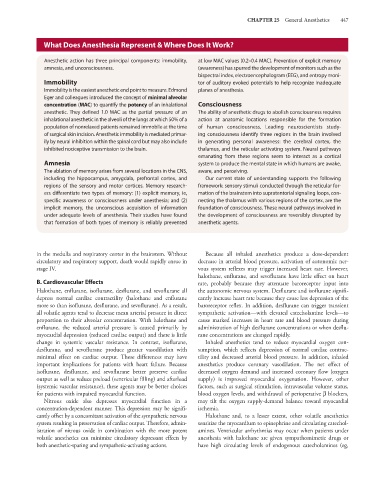Page 461 - Basic _ Clinical Pharmacology ( PDFDrive )
P. 461
CHAPTER 25 General Anesthetics 447
What Does Anesthesia Represent & Where Does It Work?
Anesthetic action has three principal components: immobility, at low MAC values (0.2–0.4 MAC). Prevention of explicit memory
amnesia, and unconsciousness. (awareness) has spurred the development of monitors such as the
bispectral index, electroencephalogram (EEG), and entropy moni-
Immobility tor of auditory evoked potentials to help recognize inadequate
Immobility is the easiest anesthetic end point to measure. Edmond planes of anesthesia.
Eger and colleagues introduced the concept of minimal alveolar
concentration (MAC) to quantify the potency of an inhalational Consciousness
anesthetic. They defined 1.0 MAC as the partial pressure of an The ability of anesthetic drugs to abolish consciousness requires
inhalational anesthetic in the alveoli of the lungs at which 50% of a action at anatomic locations responsible for the formation
population of nonrelaxed patients remained immobile at the time of human consciousness. Leading neuroscientists study-
of surgical skin incision. Anesthetic immobility is mediated primar- ing consciousness identify three regions in the brain involved
ily by neural inhibition within the spinal cord but may also include in generating personal awareness: the cerebral cortex, the
inhibited nociceptive transmission to the brain. thalamus, and the reticular activating system. Neural pathways
emanating from these regions seem to interact as a cortical
Amnesia system to produce the mental state in which humans are awake,
The ablation of memory arises from several locations in the CNS, aware, and perceiving.
including the hippocampus, amygdala, prefrontal cortex, and Our current state of understanding supports the following
regions of the sensory and motor cortices. Memory research- framework: sensory stimuli conducted through the reticular for-
ers differentiate two types of memory: (1) explicit memory, ie, mation of the brainstem into supratentorial signaling loops, con-
specific awareness or consciousness under anesthesia; and (2) necting the thalamus with various regions of the cortex, are the
implicit memory, the unconscious acquisition of information foundation of consciousness. These neural pathways involved in
under adequate levels of anesthesia. Their studies have found the development of consciousness are reversibly disrupted by
that formation of both types of memory is reliably prevented anesthetic agents.
in the medulla and respiratory center in the brainstem. Without Because all inhaled anesthetics produce a dose-dependent
circulatory and respiratory support, death would rapidly ensue in decrease in arterial blood pressure, activation of autonomic ner-
stage IV. vous system reflexes may trigger increased heart rate. However,
halothane, enflurane, and sevoflurane have little effect on heart
B. Cardiovascular Effects rate, probably because they attenuate baroreceptor input into
Halothane, enflurane, isoflurane, desflurane, and sevoflurane all the autonomic nervous system. Desflurane and isoflurane signifi-
depress normal cardiac contractility (halothane and enflurane cantly increase heart rate because they cause less depression of the
more so than isoflurane, desflurane, and sevoflurane). As a result, baroreceptor reflex. In addition, desflurane can trigger transient
all volatile agents tend to decrease mean arterial pressure in direct sympathetic activation—with elevated catecholamine levels—to
proportion to their alveolar concentration. With halothane and cause marked increases in heart rate and blood pressure during
enflurane, the reduced arterial pressure is caused primarily by administration of high desflurane concentrations or when desflu-
myocardial depression (reduced cardiac output) and there is little rane concentrations are changed rapidly.
change in systemic vascular resistance. In contrast, isoflurane, Inhaled anesthetics tend to reduce myocardial oxygen con-
desflurane, and sevoflurane produce greater vasodilation with sumption, which reflects depression of normal cardiac contrac-
minimal effect on cardiac output. These differences may have tility and decreased arterial blood pressure. In addition, inhaled
important implications for patients with heart failure. Because anesthetics produce coronary vasodilation. The net effect of
isoflurane, desflurane, and sevoflurane better preserve cardiac decreased oxygen demand and increased coronary flow (oxygen
output as well as reduce preload (ventricular filling) and afterload supply) is improved myocardial oxygenation. However, other
(systemic vascular resistance), these agents may be better choices factors, such as surgical stimulation, intravascular volume status,
for patients with impaired myocardial function. blood oxygen levels, and withdrawal of perioperative β blockers,
Nitrous oxide also depresses myocardial function in a may tilt the oxygen supply-demand balance toward myocardial
concentration-dependent manner. This depression may be signifi- ischemia.
cantly offset by a concomitant activation of the sympathetic nervous Halothane and, to a lesser extent, other volatile anesthetics
system resulting in preservation of cardiac output. Therefore, admin- sensitize the myocardium to epinephrine and circulating catechol-
istration of nitrous oxide in combination with the more potent amines. Ventricular arrhythmias may occur when patients under
volatile anesthetics can minimize circulatory depressant effects by anesthesia with halothane are given sympathomimetic drugs or
both anesthetic-sparing and sympathetic-activating actions. have high circulating levels of endogenous catecholamines (eg,

